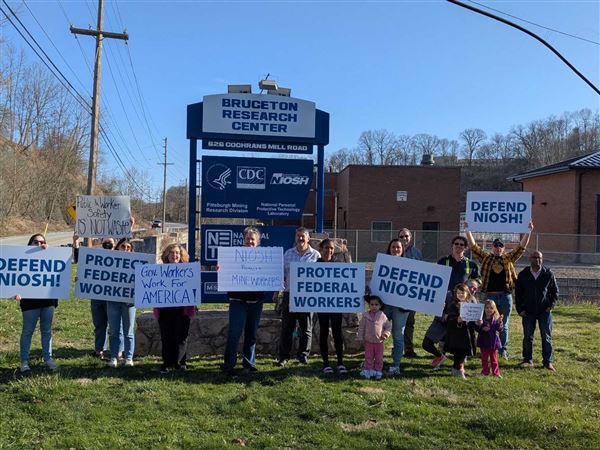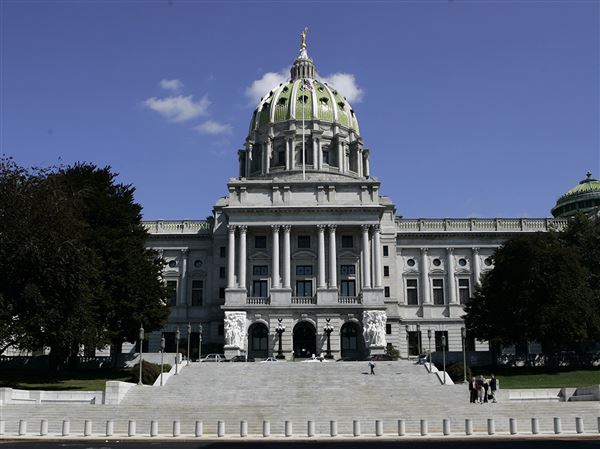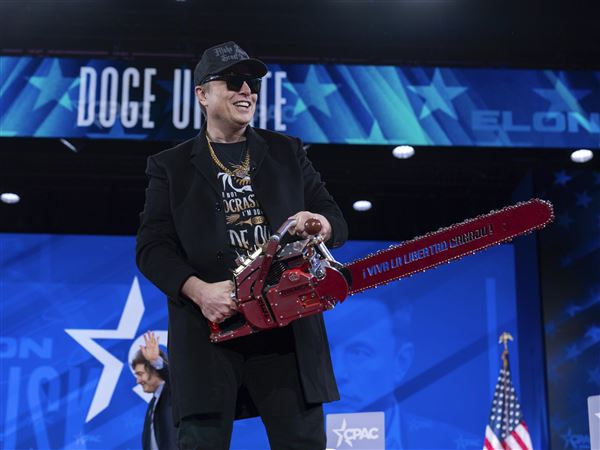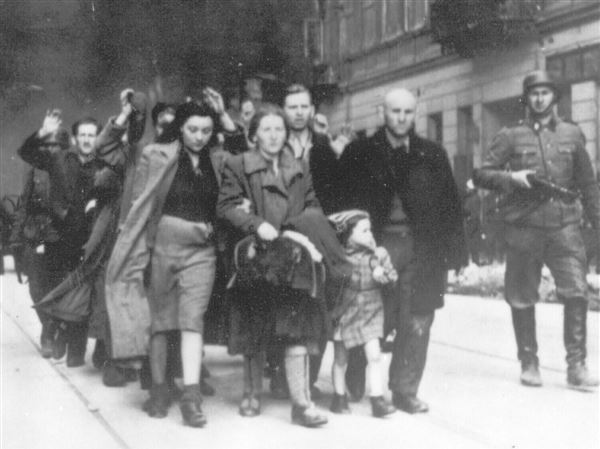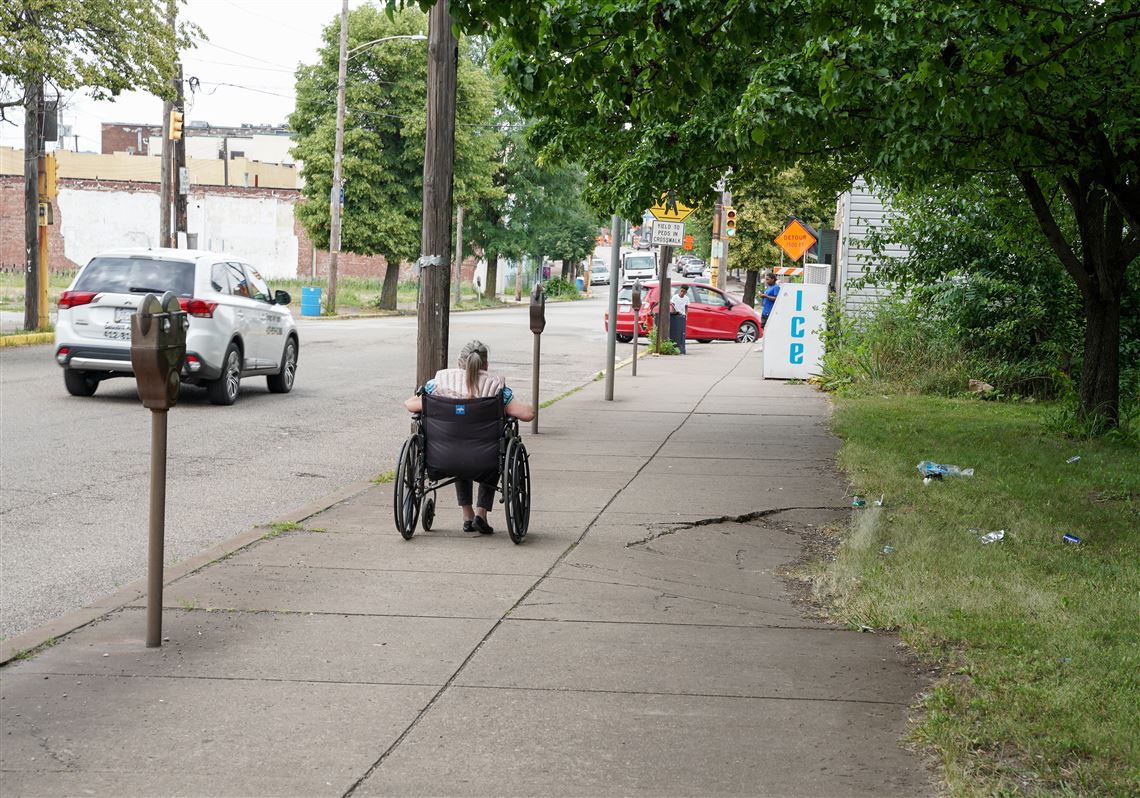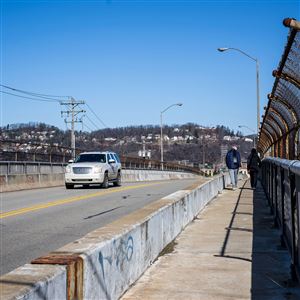Many of the sidewalks in Braddock are not good.
Some are cracked and heaved. Others are overgrown with weeds. Some simply no longer exist.
That might be a minor inconvenience to an able-bodied person, but many in this borough of about 1,700 people on the Monongahela River are older, says borough Manager Lou Ransom. They rely on a walker, a wheelchair or other assistance to get around — and for them, the sidewalks are a major infrastructure and safety concern.
“Braddock is an aging community,” Mr. Ransom said. “We have a lot of senior citizens with mobility issues ... and having cracked and broken sidewalks is an impediment for people who are using the streets, and that’s a danger.”
The problem is exacerbated by the heavy traffic — including truck traffic — along Braddock Avenue and other thoroughfares in the community, he said.
A $9.3 million project on a ramp leading onto the Rankin Bridge near Braddock will improve the sidewalk along the ramp, which has cracks, and also will reduce the number of lanes from three to two, Mr. Ransom said.
Maintaining basic infrastructure is one of local governments’ most important tasks. And it’s why Mr. Ransom acknowledges that more work needs to be done in his community.
Braddock is not alone in Allegheny County; many areas have problems that challenge residents’ ability to get around — whether on foot, by bike or in a car.
Maintaining sidewalks, creating better connectivity and improving road networks are at the heart of a bill that Allegheny County Councilwoman Michelle Naccarati-Chapkis introduced earlier this year.
Ms. Naccarati-Chapkis said that her legislation, which requires the county’s departments of economic development and public works to create a “complete streets” plan by the end of the year, is meant to get municipalities to rethink their infrastructure. The broad goals include multimodal transportation — which can mean better sidewalks, more bike lanes, trail connectivity, and redesigning roads so that they’re safer for everyone in downtown or urban environments.
“It’s an opportunity for municipalities to think holistically about their approaches,” she said.
The city of Pittsburgh has a complete streets advisory group advising elected city leaders on such issues, and at least six municipalities in the county — Dormont, Mt. Lebanon, Forest Hills, Wilkins, Millvale and Sharpsburg — already have a plan in place.
Ms. Naccarati-Chapkis wants other municipalities to emulate what has worked in those areas.
Dormont has worked on installing more pedestrian-friendly infrastructure at busy intersections, with signs and flashing indicators. Millvale has worked with community partners to complete riverfront bike trails along the Allegheny River, connecting them to its downtown core. Sharpsburg has focused on improving its business district on Main Street, improving sidewalks and creating other improvements to help those cycling and walking better navigate the area.
Ms. Naccarati-Chapkis said her legislation is meant to encourage all of those types of improvements, and highlighted that trail connections are important. Because of the topography of the region, some municipalities will need to include some of their roads as connections to larger trails throughout the Pittsburgh area.
That includes sites in the South Hills. Michael Foote, Castle Shannon’s borough manager, said trail connection is an important part of the complete streets concept. Mr. Foote, who has been manager there for about 10 months, also said sidewalk connectivity is a real issue for people who walk. Sometimes, they have to go into people’s yards to avoid walking on road shoulders, he said.
It’s all about creating a safer feel to the community, while balancing the need to get people around efficiently, he said.
An Lewis, executive director of the Steel Rivers Council of Governments that serves 19 municipalities in the Mon Valley, said she often reflects on what her late father, urban planner and Carnegie Mellon professor David Lewis, taught her about those communities, especially when they were built amongst the backdrop of busier steel mills.
Her father told her that the boroughs, townships and small cities were built “on the scale of the human foot,” meaning that people could easily walk from one side of town to the other, she said.
As automobiles took over with post-World War II prosperity and the emphasis on walking diminished — but now the towns have deindustrialized, and it’s important to come up with solutions that cater to people on foot and on bicycles, as well as those driving, Ms. Lewis said.
The effectiveness of Ms. Naccarati-Chapkis’ bill, if it is passed, will be measured by how well it facilitates outside money flowing to these smaller municipalities to reconfigure their infrastructure, she said.
“These are the smaller local governments that likely have the fewest resources to be able to accommodate and build those solutions themselves, without subsidy or support from somewhere else,” Ms. Lewis said.
The bill does not explicitly state any funding requirements, but rather sets broad benchmarks that the county’s “complete streets” plan should meet, including “link[ing] together the patchwork of municipal bike and bus lanes and sidewalks,” creating more protected bike lanes, connecting those bike lanes with off-road paths and trails, and building better infrastructure for bikes, e-scooters, pedestrians and other forms of micro-mobility.
Ms. Lewis said for the “complete streets” plan to work, funding for all of its goals is key.
The bill is currently in the council’s committee on economic development and job creation. County officials said they’re working on technical aspects of the bill, including putting “details in about Allegheny County roads and bridge programs” that help meet the legislation’s goals.
Ms. Naccarati-Chapkis said it’s unclear when the legislation might reach a final vote.
Proponents of complete streets say the model has benefits outside of safety improvements. Ms. Lewis said it also serves as a tool to revitalize main streets in municipalities and as an economic engine for local businesses.
If people don’t need a car to get around, they can walk from business to business, supporting the local economy, she said. The wrong design, where people have to get around by automobile, can lead to the opposite, she added.
“It is a core component of the ecosystem of a healthy and vibrant business district,” Ms. Lewis said.
First Published: June 17, 2024, 9:30 a.m.
Updated: June 18, 2024, 6:57 p.m.
